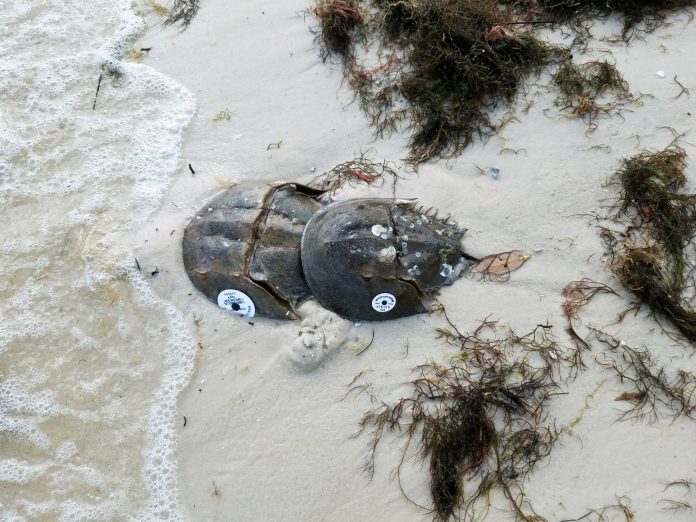When the tides and moon are just right during the spring and fall months, superheroes emerge from the sea and are spotted nesting along Florida’s coastal marshes and low-energy beaches. Beachgoers often mistake these ancient creatures to be venomous stingrays, but their long-slender tails are simply used to upright themselves when flipped by an incoming wave. Although the word crab is part of their common name, horseshoe crabs are more closely related to spiders and scorpions and resemble their archaic ancestors.
Besides being a favored prey item or many fish and wildlife, pharmaceutical companies use horseshoe crab’s unique blue blood to ensure intravenous drugs are free of harmful bacteria. Researchers worldwide are using the horseshoe crab’s unique blueblood to ensure that the COVID-19 vaccine is safe for us to administer. Scientists have been using horseshoe crab blood since the 1970s to check vaccines and equipment for contamination. Before the 1970s, patients would come down with “injection fever” when they received a shot. Sometimes these patients would recover, but many times they would become very sick and die.
So how does it work? Researchers derived LAL, Limulus Amebocyte Lysate, from horseshoe crab blood to determine if bacterial toxins are present. If the substance is not sterile, the horseshoe crab blood will clump. To break this term down further, the word Limulus comes from the horseshoe crab’s scientific name (Limulus polyphemus), from which researchers get the blood. The amebocyte is the horseshoe crab’s red blood cells, and the lysate is the contents of the broken cells. LAL tests are so sensitive that they can detect contaminants in as little as 45 minutes.
Unfortunately, information about horseshoe crab populations in Florida is lacking. Scientists are uncertain about where the horseshoe crabs hang out, where they travel to, or how big they grow. To learn more about the horseshoe crabs, trained volunteers walk beaches and record information. During the surveys, a subset of crabs is collected, tagged, and released. Each tag has a unique identification number registered to the individual horseshoe crab allowing researchers to track the horseshoe crab’s movements.
If one of these tagged superheroes is spotted, please follow these three steps:
1) Snap a picture of the tag or record the tag number. Do not remove the tag from the horseshoe crab.
2) Note the date, location, and general condition of the horseshoe crab.
3) Report the data using the online form (www.fws.gov/crabtag) or by calling 1-888-546-8587.
If a horseshoe crab flipped upside-down, please do not pick it up by its tail, which is harmful to the animal. Instead, gently place both hands on the sides of the horseshoe crab and return the animal to the upright position.
Note: The Florida Horseshoe Crab Watch is a collaboration among the Florida Fish and Wildlife Conservation Commission, The University of Florida, and the Florida Sea Grant College Program.
The University of Florida is an equal-opportunity institution.

